Kuvasz
The kuvasz is a breed of working dog originally bred as guard dogs in Europe. This large
breed is characterized by strong muscles and a white coat.
|
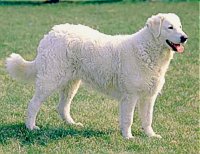 |
|
|
Doberman Pinscher
The Doberman pinscher is a cross between the Rottweiler, the German shepherd, the black
and tan terrier, and the German pinscher, and has typically been bred as an aggressive
guard dog.
|
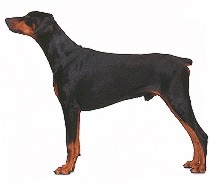 |
|
|
Great Pyrenees
The Great Pyrenees is a breed of working dog bred in the Pyrenees Mountains of
southwestern Europe to protect flocks of sheep. This large dog is characterized by thick,
white fur, a broad head, and a deep chest.
|
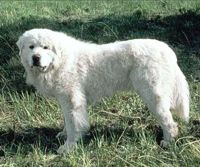 |
|
|
Newfoundland
Renowned for its excellent swimming ability, the Newfoundland has been known to rescue
humans from drowning. Once also used as a work dog, it is now principally a watchdog and
companion.
|
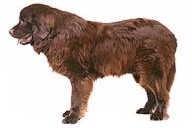 |
|
|
Rottweiler
Despite its unwarranted reputation for viciousness, the Rottweiler is one of the most
popular breeds in the United States. The powerfully built Rottweiler actually is a
solicitous and calm animal, and is used as a pet and guard dog. Adult Rottweilers reach a
weight of 41 to 50 kg (90 to 110 lb).
|
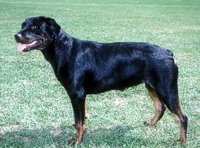 |
|
|
Alaskan Malamute
This Alaskan Malamute has dense, layered fur as a shield from severe weather. The nomadic
Mahlemuts, an Inuit people of northwestern Alaska, first bred the Alaskan Malamute as a
sled dog to haul their belongings. Ranging from light gray to black in color, Alaskan
Malamutes are also popular as pets and show dogs.
|
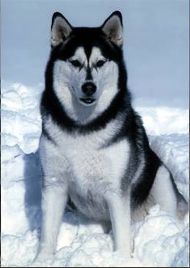 |
|
|
Akita Dog
Recognized in Japan as part of the country's national heritage, the akita dates from the
1600s, when a businessman in the city of Akita, on Honshû Island, Japan, developed the
breed. Originally bred to hunt large game, this large, independent dog grows to weigh
about 34 to 50 kg (75 to 110 lb).
|
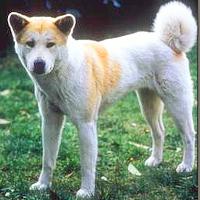 |
|
|
Siberian Husky
The Siberian husky has a dense coat of fur that allows it to weather harsh climates.
Developed as a sled dog in the 1800s by the Chukchi people of northeastern Asia, the
Siberian husky is a popular breed in sled-dog competition despite being a medium-sized
dog. Males of this breed usually measure 53 to 60 cm (21 to 23.5 in) high at the shoulder
and females are slightly smaller.
|
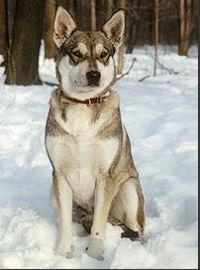 |
|
|
Portuguese Water Dog
The Portuguese water dog was bred in Portugal to fetch fishing equipment in the water.
Similar to a poodle, this working breed has enhanced webbing on the feet to facilitate
swimming.
|
 |
|
|
Boxer
Though its ancestry can be traced to the 16th century, the modern boxer was developed in
late 19th-century Germany as an aggressive hunting and fighting dog. Subsequent breeders
cultivated a much less aggressive boxer for more practical purposes. Boxers have become
popular as seeing-eye dogs, police dogs, and household pets.
|
 |
|
|
Great Dane
The Great Dane is a breed of working dog distinguished by its large size. Males measure at
least 76 cm (30 in) at the shoulder. The dog is also characterized by a smooth coat, long
head, and broad chest.
|
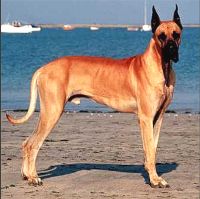 |
|
|
Bullmastiff
The utilitarian history of the bullmastiff begins with English gamekeepers during the
1800s. Gamekeepers needed assistance in warding off poachers from large English estates
and game preserves. They focused their search on domestic dogs, rejecting the mastiff for
its sluggishness and the bulldog for its ferocity. Breeders crossed the two, producing the
bullmastiff, which had the speed, courage, strength, and temperament to protect these
estates.
|
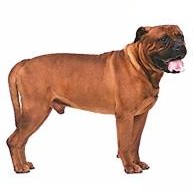 |
|
|
Mastiff
The mastiff is a giant breed of working dog originally bred for warfare and hunting. The
breed is characterized by a large body, a huge head, and a powerful neck and legs. Its
color is tan with black markings around the face.
|
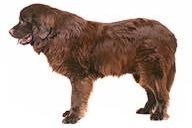 |
|
|
Samoyed
The Samoyed, named after the Samoyed people of Siberia, was originally trained to pull
sleds and guard reindeer. It has recently become a popular show dog as well.
|
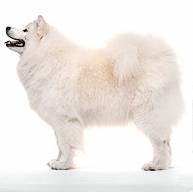 |
|
|
Komodor
A komondor is a breed of working dog distinguished by a coat of long, corded white hair
that feels like felt.
|
 |
|
|
Saint Bernard
The Saint Bernard earned its reputation as a lifesaver at the hospice of Saint Bernard,
near the Great Saint Bernard Pass of the Alps Mountains. Its keen sense of smell and of
direction allow the St. Bernard to find and rescue people who are lost or buried in snow.
|
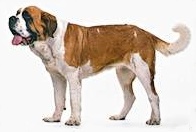 |
|
![]()
![]()















